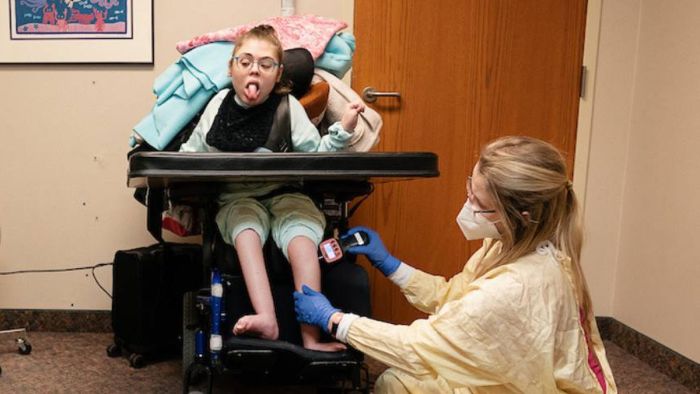Can we predict when someone might feel pain?
Gillette Children’s is doing important research to answer this question for kids with cerebral palsy (CP) through our groundbreaking Predictors of Pain study.
This study is supported by a grant from the National Institute of Health - a significant achievement for Gillette. Leading the study are Senior Clinical Scientist Chantel Burkitt, PhD, along with Clinical Scientist Liz Boyer, PhD, and Tom Novacheck, MD, head of Gillette Children’s Cerebral Palsy Institute and also an orthopedic surgeon. Gillette is partnering on the study with Nemours Children's Hospital in Delaware.
The Predictors of Pain study examines what might predict lasting pain after surgery in kids aged 5-17 with cerebral palsy, especially those getting one or more surgeries. It will continue over five years and will include as many as 500 families. Throughout the study, the team will track how kids experience pain – how strong, how often, and for how long – both leading up to surgery and after surgery.
Why research pain in kids with CP?
Dr. Burkitt says not enough research looks at how kids with disabilities feel pain. She and the research team want to understand and help manage pain for these kids. Dr. Novacheck says Gillette’s Cerebral Palsy Institute will use the study’s findings to improve the pain experience for kids with CP, not just at Gillette but everywhere.
How do we measure pain?
The study draws on multiple methods to measure pain, including online surveys and special tests that check how sensitive the kids are to touch. They also use information from Gillette’s Gait & Motion Analysis Lab, which helps researchers understand how pain affects how kids move and walk. The online surveys are important because kids and their caregivers might share more about their pain than they would in a doctor's office. Because the surveys are given before and after surgery, they help create a long-term map of participants’ individual pain experiences.
Sensory testing for measuring pain
Another method Gillette researchers are using to measure pain in study participants is sensory testing. Sensory testing involves quick tests to determine how the kids react to things like light touch, a tiny pin prick, something cool or warm on the skin, pressure, and repeated touch. These tests take less than five minutes and provide some insight into participants’ pain experience, even for kids who are non-verbal or take longer to process their feelings.
Every test is recorded, and experts spend a lot of time watching the recordings and figuring out the kids' reactions. Dr. Burkitt's team spent 10 years confirming this method of testing is accurate and can be used as a universal measure for pain.
Alleviating pain for kids with Cerebral Palsy
This study represents just one step in helping kids with CP predict and manage their pain. Dr. Burkitt, Dr. Novacheck, and the entire Predictors of Pain study team hope their work and their partnership with study participants will help inform better guidelines for care and lessen post-surgical pain for kids in the future.
Learn more about Gillette Children’s Cerebral Palsy Institute and how they are working hard to learn more about pain and help all kids with cerebral palsy here.
Enrollment for the study, which is scheduled to finish by summer 2027, is still open. Learn more about participating.
 Home Page
Home Page

